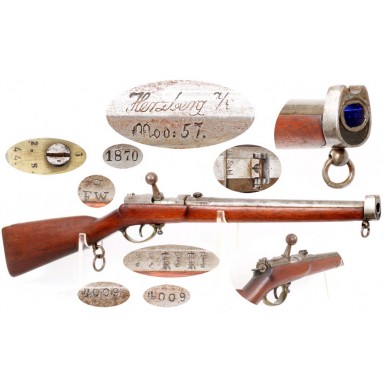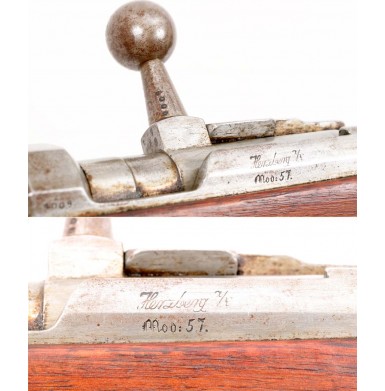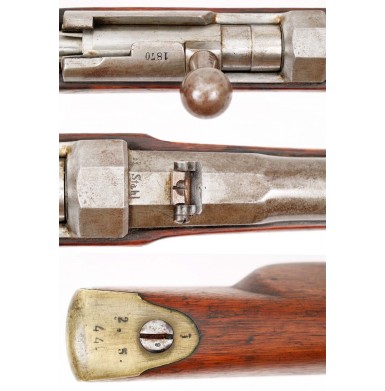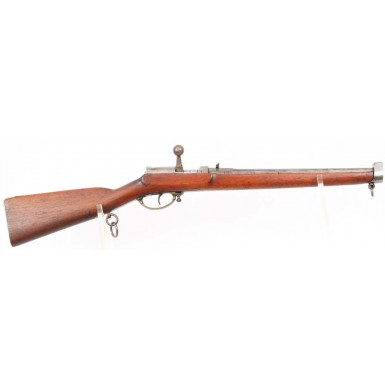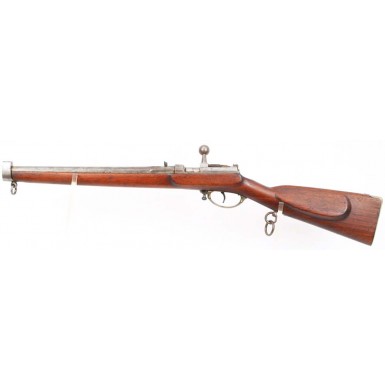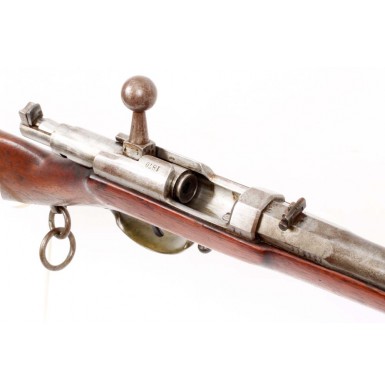In 1836 Johann Nikolaus von Dreyse revolutionized the world of military firearms by submitting his bolt action “needle rifle” to the Prussian military for testing and trials. Von Dreyse was born in SŒMMERDA, Prussia in 1787, and probably developed an interest in making and building things from his father, who was a blacksmith. From 1809-1814 von Dreyse worked for the famous Swiss gunmaker Jean-Samuel Pauly, who operated a gun manufactory in Paris. It was there that von Dreyse was probably exposed to the concept of breechloading rifles, as Pauly conducted a number of experiments during that time of various breechloading designs. Von Dreyse returned to Prussia after working for Pauly, and established a percussion cap manufactory in SŒMMERDA in1824. Von Dreyse was certainly a cutting edge of the firearms business at the time, as the percussion cap was still 10 to 20 years from worldwide acceptance. It was at this time that von Dreyse started to experiment with self-contained paper cartridges. While paper cartridges that contained black powder and projectiles had been around for nearly 200 years, they all required the use of an external ignition system; either powder in the pan of a flintlock or a percussion cap on the cone (nipple) of the gun. Von Dreyse developed a paper cartridge that contained not only the bullet and the powder, but also the percussion cap, which was situated at the bottom of the bullet, above the powder charge. Placing the cap in that location allowed the base of the bullet to act as the anvil upon which the cap could be detonated when it was struck. Von Dreyse also developed a long, needle-like pin that was tensioned by a coiled spring, and was effectively the first successful firing pin design. Initially von Dreyse applied these new developments to a muzzle loading firearm design, with the novelty being the self-contained paper cartridge and the needle fire ignition system. This did not, however, provide significant advantages over conventional percussion muzzle loading arms. Then in 1836 he applied the same concepts to his newly designed breechloading rifle that was bolt actuated. This was revolutionary, as it made the gun very fast to load and allowed it to be easily loaded while the shooter was prone, concealed or even on horseback. He submitted his design to the Prussian military, and it was accepted in December of 1840. In 1841 the new infantry rifle was designated the Leichte Perscussions-Gewehr M-1841. The name “Light Percussion Rifle M-1841” was meant to conceal the revolutionary nature of the new firearm, but by 1855 the term Zündnadelgewehr (Needle Gun) was in general use within the military. The rifle was a 15.4mm (about .61 caliber), single shot, bolt-action breechloader that looked rather like the previous generations of Prussian muzzle loading flintlock and percussion muskets. The rifle could fire 10 to 12 rounds per minute, which was an astounding rate of fire for the time. The muzzle velocity was about 1,000 ft/s and the rifle had an effective range of about 600 yards. This was somewhat shy of the 1,000 yards that the best muzzle loading rifle musket designs of the mid-19th century were capable of. The primary issue was poor gas sealing at the breech, allowing the escape of gasses at that location and reducing the chamber presser and projectile velocity. The other major drawback was the fact that the firing needle had to be very long to reach the primer deep in the paper cartridge, at the base of the projectile. This lead to issues with needle breakage and required that the soldiers to carry spare needles with them, as well as to be capable of disassembling the bolt system in the field to replace a broken needle. Despite the short comings of limited range, gas leakage and needle durability, the amazing rate of fire made the Zündnadelgewehr a fearsome weapon to be encountered by an enemy armed with conventional muzzle loading muskets. The Prussians used the Zündnadelgewehr with devastating effectiveness against the Austrian infantry during the Austro-Prussian War of 1866, where observers commented on the fact that a prone Prussian infantryman could fire 5 rounds in the time it took a standing Austrian infantryman to load his rifle one time. With the general adoption of the needle gun throughout the Prussian military, specialized models began to be developed for use by various branches of the service. Experimental cavalry carbines began to appear in 1851, but the majority of the Prussian cavalry remained armed with M-1811 smoothbore carbines, altered to percussion. Another experimental variant appeared in 1853 and then another in 1855, each trying to solve the issues associated with carrying a loaded bolt-action needle gun on horseback. The final major improvement came in 1857 when cast steel barrels were introduced and the Zündnadelkarabiner M-1857 (Needle Carbine M57) was officially adopted. Unlike the M-1841 rifle, which was a typical infantry length weapon with a 33 ““ barrel and a 54” overall length, the compact M-1857 was only 31 ““ in overall length (shorter than the barrel alone of the infantry rifle) and had a truncated 15” long barrel. The M-1857 retained the 15.4mm caliber, broad 4-groove rifling and the needle fire bolt-action system. Like all of the Dreyse designed arms of the period, it retained the stock flats on either side of the breech that resembled the flat opposite the lock of a conventional percussion weapon of the time. The carbine was stocked to the muzzle and was provided with two sets of suspension rings for the cavalryman to sling the carbine by. A double set of rings behind the triggerguard and single ring under the muzzle. The front sight was protected by a pair of “ears’ that projected from the nose cap, and the rear sight consisted of a simple block graduated to 200 schritt and an additional folding leaf graduate to 350 schritt. A schritt was a Prussian “step” or about .73-.74 of a meter, which is roughly 2.4”, so the sights were graduated to approximately 480” (160 yards) and 840” (280 yards). The furniture was a combination of iron and brass and the stock was the traditional Prussian beech. The first issues of M-1857 carbines stared in 1859, with initially 16 troopers per squadron receiving the new guns. The carbines were issued to dragoon and hussar regiments as defensive weapons, as the horsemen were expected to attack in the traditional European manner with the saber. The regiments of Uhlans (lancers) and Cuirassiers (heavy cavalry) did not receive the M-1857, but rather relied upon their traditional offensive weapons of lance and saber, and were issued obsolete M-1850 and M-1823 smoothbore pistols for defensive weapons. The M-1857 was initially produced at the Dreyse factory in SŒMMERDA (Prussia) that majority of the carbines were produced there. After 1866, however, the carbines started to be manufactured at the Adolph Krause Factory in Hertzberg (Saxony). After the Prussian victory in the 1866 Austro-Prussian War, many of the southern German states pledged their loyalty to Prussia, and the Prussian shared their military technology and weapons with their new allies. M-1857 carbines were utilized by the Saxon cavalry as was as the Bavarians, and with the outbreak of the Franco-Prussian War in 1870 they saw more general service throughout the mounted regiments of the German states. The Prussian cavalry tended to serve in the traditional European cavalry roles with heavy cavalry charging infantry with lances or sabers and the light cavalry serving as scouts. The lessons of the American Civil War, where cavalry was used as mounted infantry to move large fighting forces quickly on the battlefield had not yet been fully learned and understood in Europe. When Prussian cavalry armed with the M-1857 needle carbines encountered the French troops armed with the M-1866 Chassepot rifle, they quickly found out that they were substantially “out-gunned”. The Chassepot was also a derivative of the “needle rifle” design but was a significant improvement over the Prussian version and utilized a higher velocity, smaller bore cartridge to devastating effect. Even though the French lost the Franco-Prussian War, the Prussians discovered that their needle-rifles were now obsolete and in 1871 they adopted a new bolt action, small bore rifle design by Paul Mauser, which started to replace the needle guns with the infantry during the early 1870s and with the cavalry there after. The M-1857 remained in production through 1873, but at that point the obsolete carbines were already being relegated to use by secondary troopers like stretcher-bearers and supply train troops.
The Zündnadelkarabiner M-1857 is one of the rarer, later production guns produced by Krause in Herzberg. The top of the receiver is clearly marked with the manufacturing date 1870, indicating that this carbine was made at the outset of the Franco-Prussian War (1870-1871). The left side of the receiver is marked in two lines in script: Herzberg / Mod: 57. The top of the barrel is marked Stahl at the breech junction, indicating that it is made of steel. The right side of the breech and barrel are marked with a plethora of crown over letter military inspection marks. The left side of the receiver is serial numbered 4009 as is the left side of the barrel and the bolt handle. The balance of the small parts numbered with a 9, the last number of the serial number. The forward left portion of the barrel, just forward of the breech is marked with the final military inspection mark of a (CROWN) / FW for Wilhelm I, King of Prussia (1861-1888) and subsequently the First Emperor of a unified Germany (1871-1888). The carbine was probably issued to Saxon cavalry regiment, as it was manufactured in Krause’s factory in Herzberg. The top of the brass buttplate is unit marked 2 . 5 / 44 (2nd Regiment “ 5th Squadron “ 44th Carbine) and does not have the usual Prussian designating letters for Uhlans, Dragoons, Cavalry, etc. suggesting it was not Prussian issued. The carbine is 100% complete and correct in everyway, with only the firing needle showing any damage. As is so often the case, the front portion of the needle is broken off, so it does not protrude from the bolt face and would not ignite a cartridge if one were available for the carbine. The rear portion of the needle is present and the firing action of the carbine still works perfectly. The carbine is in excellent mechanical condition and the bolt and firing mechanism both function smoothly and correctly in every way. The original rear sight is still in place on the rear of the barrel, complete with the folding leaf. The sight leaf retains about 30% of its original fire blued finish. The carbine also retains its original double sling rings behind the triggerguard and the single ring below the muzzle. The carbine is in about VERY GOOD+ to NEAR FINE condition overall. The metal of the barrel and the iron furniture are mostly smooth with a slightly dull, gunmetal gray patina. The carbine was obviously coated in Cosmoline or some other heavy oil for a long time, and the remnants of the oil and accumulated dirt and grime are present in all of the nooks and crannies of gun. It would be worth carefully cleaning this old grease and dirt off the metal. The metal shows some lightly scattered freckling and minor surface oxidation along with a very small amount of scattered pinpricking, but is free of any pitting. The bore of the carbine is in VERY FINE condition and is almost entirely bright with excellent, crisp rifling. The bore shows only some light frosting and pinpricking in the grooves, and were appropriate ammunition available (and the firing pin replaced) it would probably shoot very well. The brass furniture of the carbine has a lovely, untouched mustard patina. The stock of the carbine is solid, full-length and complete and free of any breaks or repairs. There is a small grain-drying crack visible at the front of the forend, surrounded by the nose cap, but otherwise the stock appears free of any damage. The stock has been lightly sanded; leaving the inspection marks on the stock faint and smeared. Thankfully, the edges and lines of the stock were not significantly affected and the carbine stock remains fairly crisp, including the cheek rest. The stock is slightly dry and would probably benefit from the application of a small amount of quality wood oil like Kramer’s Best.
Overall, this is a very nice example of a very scarce Zündnadelkarabiner M-1857 (Needle Carbine M57), with a desirable Franco-Prussian War manufacturing date. The carbine is complete and correct in every way and has no detractions other than the damaged needle and the lightly sanded stock. The gun has a very attractive look and is mechanically functional and has good unit markings on the buttplate tang. For any collector of needle firearms or early Imperial German weapons, this is a very nice example of quite a scarce gun to add to your collection.
SOLDTags: Dreyse, Zündnadelgewehr


